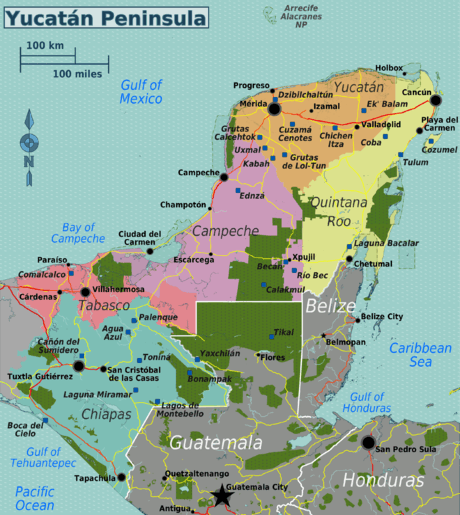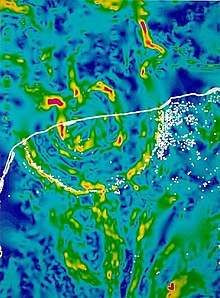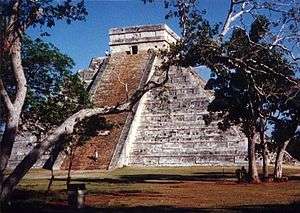Yucatán and the South
The Yucatán Peninsula is a region of southeastern Mexico, consisting of the Mexican states of Yucatán, Campeche, and Quintana Roo.
The Yucatán was the home of the Maya civilization before it was conquered by the Spanish Conquistadors in the 16th century. Much of the population is part or all of Maya descent, and in many places the Maya language is still spoken, usually in addition to Spanish, the main language of business.
Until the mid 20th century, most of the Peninsula's trade with the rest of Mexico was by sea, and the culture, cuisine, and traditions developed different flavors from other parts of Mexico. Starting in the late 20th century the Yucatán has become more integrated into Mexico, especially such areas on the Caribbean coast as Cancún and Chetumal, where many people from other parts of the nation have moved to take advantage of the economic opportunities of development. The Mayan Riviera stretching south from Cancún has seen the most growth related to tourism.
States

| Quintana Roo Heavy tourist traffic is lured to the northeast of the state, notably by the infamous party city of Cancún, but also by the endless gorgeous Caribbean white sand beaches, some of the world's greatest scuba diving, beautiful cenotes, and a few excellent Mayan sites. |
| Yucatán The Mayan capital of Mexico is home to famous Chichen Itza, but also to more beautiful cenotes, caves, pretty colonial cities, a vibrant capital in Mérida, and is well known as Mexico's safest state. |
| Campeche Decidedly further off the beaten path than busy Yucatán or Quintana Roo, Campeche has its own magnificent Mayan ruins, which you can explore in the quiet of your own company, as well as the touristic beach city of Ciudad del Carmen. |
| Tabasco A state better known for hot sauce than tourism, there are nonetheless a few worthwhile stops here for a cross-country traveler, notably the immodestly named beach town of Paraíso. |
| Chiapas At the southern end of the Peninsula, with the only Pacific coastline in this region, is Chiapas, most notable for the impressive Mayan ruins at Palenque and the colonial town of San Cristobal de las Casas, but also for the beautiful natural, jungle areas in the state's east. |
Cities
- 🌍 Campeche - moderately sized city with Spanish ruins
- 🌍 Cancún - beach, modern tourist resort
- 🌍 Chetumal - capital of Quintana Roo, located on the Caribbean coast, close to the Belizean Border with a nice Mayan Cultural museum
- 🌍 Izamal - small mostly Maya city with large colonial convent and remains of large Maya pyramids
- 🌍 Mahahual - small coastal town, recently a Cruise ship destination called the Costa Maya
- 🌍 Mérida - colonial city, the metropolis of the Yucatán
- 🌍 Playa del Carmen - was a nice fishermen's town, now has lots of resorts
- 🌍 Progreso - port city with beaches and seafood north of Mérida
- 🌍 Valladolid - small colonial city
Other destinations
- Cozumel - an island with beaches and ruins
- Mayan Riviera - the stretch of coastline between Cancún and Tulum (which includes Playa del Carmen), it is a quickly-developing resort area that still maintains a relaxed atmosphere in contrast to the city of Cancún
- Cenotes of the Yucatán - unique underground cave systems with unique snorkeling and scuba diving opportunities
- Lol-Tun - an underground cave system, two hours south of Merida
- Mahahual - laid back beach area
- Mesoamerican Barrier Reef
- Xpujil - a remote inland village, with unique Mayan cultural sites, and jumping-off point for visits to the Reserva de la Biósfera Calakmul
Extensive Maya ruins are scattered all over this region, most of which are easily accessible by bus or car. Some of the more important include:
- Becan - large ruin in the lower center of the Peninsula, little restored
- Calakmul - large ruin in jungle preserve, off the tourist trail
- Chichen Itza - the largest, most restored, and most visited of Yucatán's Maya ruins
- Coba - large ruin that has undergone little restoration
- Cuzamá - home of three beautiful cenotes
- Dzibilchaltún - moderately sized ruin with only a few buildings restored, worth a look on the road between Mérida and Progreso
- Ednza - discovered in the 1950s, the well preserved site an hour's drive from Campeche
- Kabah - medium-sized ruin south of Uxmal
- Mayapan - historically important, but less interesting to see than Yucatán's other famous ruins
- Palenque - dramatic ruins in the southwest of Mexico's Mayan region
- Tulum - the tropical beach backdrop is the main attraction of this picturesque, much-visited small ruin on the shore of the Caribbean Sea
- Uxmal - one of the most beautiful of all Maya ruins, a large, well-preserved site with fine architecture
Understand
The Yucatán has a a rich cultural history. Yucatán is famous for ancient Maya ruins such as Chichén Itzá. Contrary to what some people may think, Mayan culture never "disappeared" and is still very much alive, with most of the Yucatán still predominantly being ethnically Maya. Referring to locals as Mexican rather than Maya, may risk offending them. During colonial rule and after independence, the Yucatan remained culturally distinct from the rest of Mexico because of its isolation. With the first railway and highways only linking it with the rest of the country from the mid-20th century. Before that most trade was by sea with Cuba, Spain and the rest of Mexico.
The region has had a turbulent history. The Maya civilization flourished in the Yucatán Peninsula for more than a thousand years before the Yucatán was conquered by the Spanish in the 1500s. After the Spanish conquest, the region had a colonial caste system with Spanish-born Europeans on top of the social ladder, and pure Mayans coming last. Independence was declared in 1821 before joining Mexico in 1823. Independence was declared for the second time in 1841, with the region remaining independent for seven years, and even flirting with annexation by the United States (the bill even cleared the House of Representatives). In 1847, a caste war broke out between the Mayans and European-descended Criollos. After the war, an independent Mayan state controlled a large part of Quintana Roo, roughly stretching from Tulum to the Belize border. This area was reincorporated in Mexico at the beginning of the 20th century.
The Yucatan has a distinctive ecosystem as a vast limestone peninsula. Ecologically, it's very different from the rest of tropical Mexico, and more similar to Northern Guatemala and Belize, being all on the same peninsula and in geographical Central America. One of the unique features of the landscape are Cenotes.Cenotes are caves or pools of stagnant water that were formed by erosion of limestone. These can range from tiny water wells to huge natural caves. They were one of the few reliable sources of water for the Maya during their heyday. While their exact role is still open to some debate objects and remains (both animal and human) found in some of them indicate an important religious role. While some Cenotes are closed due to their religious, cultural, or archaeological significance, there are many that you can swim or dive in with or without guides.

Near Merida is also the place of the Chicxulub meteor impact, that is (according to whom you ask) partly or entirely to blame for the end of the dinosaur age 65 million years ago. While hardly anything of it can be seen today, the location of some cenotes (see below) is a good indicator for the size of the crater as they still form a circle segment that when followed to the ocean gives you the full size of the impact crater.
Talk

Spanish is the main language. English will be understood in most tourist locations and resorts. Knowing a few phrases of basic Spanish will help away from the main tourist resorts and can often help you find better deals. Yucatecos are generally tolerant of visitors who do not speak Spanish fluently but appreciate the effort to learn Spanish.
In much of the Yucatán some Maya is spoken. Except in a few small villages, almost everyone will have at least a working knowledge of basic Spanish.
Maya place names are usually accented on the last syllable, otherwise generally pronounced the same as in Spanish. The letter "X" in Yucatán is used for the sound in the Maya language that's the same as "Sh" in English. For example, "Uxmal" is pronounced "Oosh-MAL".
Get in
By plane
The peninsula has three major airports. Cancún, Merida and Cozumel. With Cancun having by far the largest offering flights to major destinations all around Mexico, North America, Central America and Europe. Mérida has frequent flights to most major Mexican cities. Chiapas's major airport is located in Tuxla Guttierez and has frequent flights to Mexico City, Monterrey and Guadalajara. Palenque also has a small airport.
By bus
From the west through the Chiapas region. Buy tickets for long journeys in advance, particularly at busy times such as weekends and public or religious holidays.
Check Ticketbus for times and prices. Only rule out overnight buses for what you would miss en route.
By train
There is no remaining passenger train service in the Yucatán Peninsula. After the federal government privatized the railways, all but two long distance passenger services across the entire nation were discontinued. While there were plans to build a new (high speed) rail line and possibly also build one through Yucatan, economic problems (mostly due to falling oil prices) have postponed if not canceled these plans as of late 2015.
Get around
By bus
Many different class buses are available to/from all the major and many of the minor cities. Mexican first class buses are excellent value and remarkably comfortable - comparable to European train services. Many cheaper services are also available - from second class (little noticeable difference really) to very basic minibus and truck services. Safety seems to decrease with price, however - second class and below may lack seatbelts. Beware of the excessive air conditioning that seems to be a feature on most services - the bus may be many degrees colder than the outside air, and being stuck on a twelve hour journey without adequate clothing can make a journey singularly unpleasant. Travelling second class is not recommended for taller people. As second class busses hold more seats than first class ones do, there is almost no leg room. The major first class bus line is Autobuses del Oriente (ADO). Most of the smaller lines (Mayab, for example), are owned by ADO.
By combi
Combi are collective-taxis that offer inter- and intra-city services. Cheaper than a taxi and usually faster than a bus since it makes fewer stops.
By taxi
Available for hire even in small towns. For long distances however, like the caves at Lol-tun, be sure to agree on a price before boarding, or you might get ripped off.
See
- Mayan archeological sites. Yucatán is home of several famous Mayan archaeological zones. The best known and most widely visited by tourists is Chichén Itzá, the site of the Kukulcan Pyramid, the Maya Observatory, and the Sacred Cenote. A contrasting cultural style, more ornamental, can be observed at Mayan sites along the Ruta Puuc. The most famous Mayan sites in Quintana Roo are located at Coba and Tulum.
 Temple of the Warriors at Chichen Itza
Temple of the Warriors at Chichen Itza - Equinox: The period when the Earths sun is directly above the equator, about Mar 20 & Sep 23 of each year. Mayans are very dependant on astronomy as reflected in their art and Temples. At Chichen Itza, during sunset on the Equinox, the shadows of the serpent-god Kukulcan, moves down along the pyramid, a very impressive sight! Other structures have Equinox related events that take place on those days also, like Tulum.
- Ecological parks: The Yucatán Peninsula is site of several Ecological Parks, like Xcaret, Xel-Há and Garrafón; aimed for the conservation of the flora and fauna of the region, which serve as well as tourist attractions. At these parks you can know more about the Mexican culture, and also enjoy several activities as swimming with dolphins and snorkeling.
Itineraries
- Cenotes of the Yucatán are complexes of sinkholes and caves in the Karst geological landscape of the Yucatán. Some cenotes contain spectacular cave formations, while others are important archeological sites, and several were considered sacred by the Mayans. A few are open to the public for swimming and diving. The states of Yucatán and Quintana Roo have established a "tourist corridor" called La Ruta de los Cenotes along which many of the most spectacular or famous cenotes are situated.
Do
- Reef diving and snorkeling. The Mesoamerican Barrier Reef, the second largest coral reef system in the world, lies offshore in the Caribbean east of the Yucatán. It extends all the way to the Bay Islands of Honduras.
Eat
Yucatecan food has its own culinary traditions developed from the long mix of native Maya and Spanish traditions. While some dishes can be very spicy, many others are not.
Common meats are turkey, chicken, pork, and deer. Yucatecan venison is quite good and not "gamey" tasting.
Typical dishes include:
- Pibil dishes, most commonly "pollo pibil", the chicken version, slow cooked in a banana leaf, very tender and tasty. "Cochinita pibil," the young pig version, is a Yucatec classic. Both dishes are seasoned with a red-colored, mild spice called achiote. "Pib" is Yucatec-maya for the cooking technique of wraping in bananna leaves and cooking in a pit.
- Poc chuc pork marinaded with salt, onion, lime juice, and spices.
- Huevos Motuleños are eggs on tortillas with black beans and cheese, often with other ingredients such as ham, peas, and tomato sauce.
- Pollo Motuleño, a chicken dish cooked with orange juice, achiote and plantains.
- Sopa de lima, tasty lime based vegetable soup with bits of corn tortilla.
- Panuchos - "sopes" with pork (called cochinita pibil)
Seafood is also very important, especially in Campeche. Pulpo (octopus), cazon (shark), camaron (shrimp) and various other tropical fish are very popular.
Contrary to the advice of many guides, the food served in all-inclusive resorts may have been prepared in far less safe conditions than that available in local establishments away from the major tourist zones. Poor refrigeration, retaining food beyond safe time limits and poor hygiene have been reported from many resorts - whereas street vendors patronised by locals have little choice but to maintain high standards, as everything is on view and their business is dependent on their reputation, not passing foreign visitors.
A good approach for regular restaurants is to note those with a lot of locals and to patronize them.
Drink
Tap water is not generally advised for drinking in Mexico, particularly for visitors. In many places (particularly backpacker-friendly resorts) water containers can be filled with drinking water for a few pesos - so a reusable container is both an environmentally and financially better option.
The water system in Mérida is unusually good for Mexico; for some visitors it is the only Mexican city where they will drink the tap water. Outside of this city the situation is different. In small towns the local water can be very bad, and bottled water is recommended.
It would be difficult for anyone visiting this area not to sample the Tequila, which should be used in moderation. For those more adventurous souls, Absinthe is legal in Mexico and also, moderation is suggested. Fresh fruit juice is very popular in The Yucatán and freshly squeezed OJ can be found in most markets. Dairy products, including cheese, should be avoided, unless you are positive they have been made with pasteurized milk.
Respect
Away from beaches and tourist hotels going around in a bathing suit or short shorts is considered improper and rude.
Stay safe
Strict drug possession policy exists in Mexico. Be very careful even with "greens". Local police are hopelessly corrupt and love to catch unwary tourists with small quantities of marijuana. Threatening long prison terms, whether this is a likely outcome is a moot point, their main aim seems, unsurprisingly, to exact bribes: in some areas a fairly standard 50% of all the traveller's money.
Caution is also advised on long bus journeys, particularly across state lines, as police or military checkpoints exist and passengers may be asked for identification or searched. In general, however, these checks seem to be aimed at locals, particularly in the Zapatista homeland in Chiapas.
Go next
The Yucatán is a good launching point for going to Chiapas, Belize, Cuba and Guatemala.